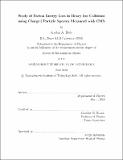Study of parton energy loss in heavy ion collisions using charged particle spectra measured with CMS
Author(s)
Baty, Austin A.
Download1132808066-MIT.pdf (11.55Mb)
Other Contributors
Massachusetts Institute of Technology. Department of Physics.
Advisor
Gunther M. Roland.
Terms of use
Metadata
Show full item recordAbstract
The phenomenology of the strong nuclear force is still not well understood at low momentum transfers and requires experimental input to constrain. Collisions of heavy ions at the Large Hadron Collider provide a unique opportunity to explore this kinematic region because they create a novel form of matter: the quark-gluon plasma (QGP). Using the CMS detector, spectra of charged particles originating from protonproton (pp), proton-lead (pPb), and lead-lead (PbPb) collisions at a center of mass energy per nucleon pair ( [square root of SNN) of 5.02 TeV are examined as a function of transverse momentum and centrality. Nuclear modification factors and fragmentation functions are constructed from these spectra. By comparing to pp collision reference spectra, a puzzle concerning previous measurements in pPb collisions is clarified. A strong suppression of particle production observed in PbPb collisions is also quantified. Finally, collisions of xenon nuclei are also studied to constrain the path length dependence of parton energy loss. The strength of energy loss is found to increase with both [square root of SNN and the average path length through the QGP. Comparisons to theoretical models and previous measurements indicate that the path length dependence is between linear and quadratic, as expected from a combination of collisional and radiative energy loss mechanisms.
Description
This electronic version was submitted by the student author. The certified thesis is available in the Institute Archives and Special Collections. Thesis: Ph. D., Massachusetts Institute of Technology, Department of Physics, 2019 Cataloged from student-submitted PDF version of thesis. Includes bibliographical references (pages 223-245).
Date issued
2019Department
Massachusetts Institute of Technology. Department of PhysicsPublisher
Massachusetts Institute of Technology
Keywords
Physics.